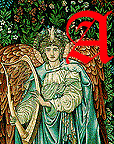[In this passage from Pre-Raphaelitism and the Pre-Raphaelite Brotherhood, Hunt's credits Morris & Co. with improving English taste but then qualifies that praise because it depended so heavily on Gothic Revival designs, which Hunt associated with the so-called "Early Christian" school of Overbeck and other German artists. (I based the decorated initial “A” on a tapesty by Burne-Jones. — George P. Landow.]

bout this year, 1861, Rossetti persuaded Morris to use the promising artistic power he had shown as a subject painter to take up decorative design. Having capital in hand, this energetic man of genius and of good business capacity incorporated Brown, Rossetti, Burne-Jones, and others, founding a firm which, after some eccentric experiments, developed not only into a commercial enterprise, but into a school of taste which it is not too much to say went far, and ought to be still moving forward, to reestablish the best form of artistic invention for English crafts.
The archaic spirit of Gothic times which inspired this offshoot from P.R.B.-ism was undoubtedly a recommendation to the approval of contemporary connoisseurs, for ancient authority has ever been what dilettantism loves as orthodoxy in art; perhaps even in the attainment of artistic success it was of good augury, for the field to traverse was limited, and the men whom Rossetti had enlisted, being late in application to art, could attain their ambition more speedily than had the region before them been of untried boundless extent. [I, 120-22]
Morris & Co. “overcame the servile minds of Pugin, Barry, and Gilbert Scott”
From small experimental beginnings Morris, allied with Madox Brown, Rossetti, Burne-Jones, andPhilip Webb, acting, as I have shown, upon an idea promulgated by Millais and myself twelve years earlier, gradually developed a system of ornamentation so royal and perfect in principle, that again the spirit of British taste, which had produced the old cathedrals, the rich wood carvings of varying types and ages, the choice embroideries, the gorgeous metal work of iron, gold and silver, the graceful fittings of old English homes, the exquisite Wedgwood ware, and the old Worcester and porcelain work, had been reawakened. The vulgar ugliness of design introduced in the Regency days exemplified by the Brighton Pavilion and mahogany monstrosities of furniture now appeared to have received its death-blow. The new spirit did not stay its hand with the conquest, but when mature .also overcame the modern Gothic introduced by the servile minds of Pugin, Barry, and Gilbert Scott. William Morris and his band did their work honestly and well; whether the world can duly appreciate and profit by the service will depend very greatly upon the influence of the press. If this be moved only by the constant love of new sensations and ceaseless hunger for foreign influence, as indeed may be somewhat feared, "sin lieth at the door," not of the artists, but at that of the men who occupy the post of leaders of public taste. Ten or fifteen years ago there could have been no hesitation on the part of any competent authority to decide that a most effectual and apparently permanent progress had been established in the forms and decorations of objects connected with our daily life. This had grown up, year by year, very slowly at first, from 1861 until the adoption of Morris's control and superintendence in house furnishing was regarded as a necessity for all aspiringly fashionable people, but, alas ! it proved to be nothing but a game of follow-my-leader. [II, 406]
Related Material
Bibliography
Hunt, William Holman. Pre-Raphaelitism and the Pre-Raphaelite Brotherhood. 2 vols. New York: Macmillan, 1905.
Last modified 26 October 2012